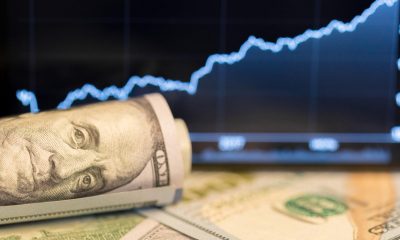Cryptocurrency
Leased proof-of-stake (LPoS), explained

Understanding leased proof-of-stake
LPoS is a type of PoS meant to increase mining power, address inherent issues found in PoW, and improve other types of PoS, such as delegated proof-of-stake (DPoS).
Regular cryptocurrency users have probably come across the term proof-of-stake (PoS) when dealing with crypto staking, but what is leased proof-of-stake (LPoS), and is there a connection between the two?
Yes, they are related, as LPoS is simply a variant of the PoS system. Proof-of-stake is a key element of the blockchain consensus mechanism, where validators participate in staking to generate and validate transaction blocks.
Validators on proof-of-stake platforms typically have to stake more cryptocurrency to improve their chances of block generation, and here is where LPoS comes in handy. Tokenholders who don’t have the technical know-how or financial muscle can lease their tokens to validator node operators, enhancing the validator’s chance to receive the opportunity to create new blocks. In return, they will earn a share of the transaction fee paid to the validator.
In an LPoS environment, tokenholders can lease their stake or run a full node. However, the more tokens staked by a node, the better its chances of being selected to generate a new block. LPoS allows users to acquire the proceeds of mining without going through the mining process.
How leased proof-of-stake works
LPoS operates on the same premises as a lottery in that more stakes increase someone’s chances of winning rewards.
So, how does leased proof of stake work? The LPoS system follows a series of set processes:
- Create a lease transaction: Tokenholders lease coins to a node, specifying the amount and recipient address. Leases can be canceled at any time.
- Wait for block generation: Leased funds join a node’s pool, increasing the chance of winning the next-block lottery.
- Consensus participation: LPoS lets leasers join the consensus process; larger nodes have better odds of generating the next block.
- Generate blocks: Winning nodes validate transactions, compile them into blocks, and earn transaction fees as rewards.
- Share rewards: Node operators distribute rewards to leasers based on their investment, with higher stakes leading to more substantial rewards.
Please note that the leased tokens never actually leave the leaser’s hardware wallet and remain in total control of the tokenholder. The holder only links the chosen node(s) and doesn’t transfer the tokens to the said node.
No party can trade or transfer the tokens, including the holder. The holder can only transact or spend the allotted coins upon canceling the lease.
Key features of leased proof-of-stake
Some of the features of LPoS include decentralization, balance leasing, fixed tokens and scalability.
The main features of LPoS include:
Balance leasing
Leased tokens do not transfer to validators, nor can they be traded. Users can lease out their tokens and money from cold storage or wallets.
Decentralized
LPoS divides rewards based on the staked amount, doing away with the need for a mining pool. It’s also great for blockchain governance, as it uses a peer-to-peer protocol to prevent third-party intervention.
Unpredictable block generation
There’s no way to predict who will win the right to generate the next block. The only thing worth noting is that the bigger a node’s economic stake, the greater its chances of winning the right to generate the next block.
Fixed tokens
Mining does not add more tokens to LPoS, as the system only allows token leasing.
Scalability
Developers of LPoS prioritize high-on-chain scalability over second-tier apps.
Rewards
Other blockchain systems offer block token rewards, but LPoS issues transaction fees to reward successful node operators.
The role of LPoS in blockchain validation
LPoS is a type of PoS used to validate cryptocurrency transactions in a blockchain network.
LPoS utilizes nodes or network devices to verify and validate blockchain transactions. Node-based validation uses computational randomness, hinged on the financial stake of a node, to assign rights to validate blockchain transactions.
A PoS consensus algorithm relies on these factors to determine what node is best fit to validate transactions at any given time:
- Age of tokens: The longer the staked tokens remain unused on the LPoS platform, the better the chances of being selected to validate the next transaction. The instant the stake verifies LPoS transactions, its age resets to zero.
- Size of stake: The greater the stake, the better the chance of validation selection.
PoS uses passive cryptocurrency deposits rather than the raw computational power in mining hardware used in proof-of-work (PoW) systems, making PoS more resource-efficient than PoW.
Currently, two leading blockchains use LPoS. The first is the Waves blockchain, which uses the LPoS consensus algorithm to verify the blockchain’s state by allowing users to lease tokens to generating nodes and receive rewards distributed by these nodes. Finally, Nix utilizes a permissionless staking mechanism that allows users to stake through a different third-party wallet, with the third party responsible for the staking.

Benefits of leased proof-of-stake
The many benefits of LPoS stem from gaining rewards without actively trading, increasing your chances of receiving rewards by joining a larger node, and the inherent security features hard-baked into the LPoS process.
One can realize several benefits from engaging in LPoS:
Passive investment
Users can participate in block generation and receive some rewards without actually participating in the block-generating process.
Allows smaller investors to participate
LPoS protocols contain a minimum investment requirement for network participation. For instance, Waves only allows a node to participate in block generation if it has a minimum of 1,000 Waves (WAVES). Investors with less than this can lease cryptocurrency tokens to more prominent nodes for a chance at gaining rewards.
Difficult to manipulate
The LPoS generating balance rule calculates the lowest balance after considering leasing in the latest 1,000 blocks, thwarting manipulation attempts by moving funds between accounts.
Increases chances of winning rewards
The LPoS works in a way that rewards nodes with the most significant economic stake in the network. Therefore, leasing tokens to a bigger node increases the chances of receiving rewards than if the leaser decided to go solo.
Retain ownership
No one can trade or transfer the leased tokens (which won’t even leave the wallet), minimizing the chances of loss.
Low barrier to entry
It does not require mining hardware to participate in validation.
LPoS crypto mining alternatives
Alternatives to LPoS that utilize PoS include delegated proof-of-stake, pure proof-of-stake and proof-of-validation.
While technically not a way to mine cryptocurrencies, PoS allows users to validate transactions and create new blocks on a blockchain. LPoS enables users to lease crypto tokens to nodes that validate LPoS transactions.
Several alternatives to LPoS allow users to make use of the PoS consensus mechanism:
Delegated proof-of-stake (DPoS)
Users can delegate the production of new blocks to delegates or witnesses through a democratic voting system, with votes weighted by the number of tokens held on a platform.
Pure proof-of-stake (PPoS)
This one is mainly used by the Algorand blockchain for the development of decentralized applications (DApps). Users can cast their votes to select representatives who vote on proposals and propose new blocks.
Proof-of-validation (PoV)
This aims to achieve consensus through staked validator nodes. The number of tokens staked with each validator determines the validator’s voting numbers. When a validator with a minimum of two-thirds of the network’s total voting submits a commit vote on a block, that validates the new block.
Hybrid proof-of-stake (HPoS)
Some LPoS protocols leverage the power of PoS and PoW. They use PoW to create new block housing transactions and use PoS to validate the blocks.
Cryptocurrency
Ethereum Foundation, Whales, and Hackers: What’s Driving the ETH Sell-Off?

TL;DR
- Whales, hackers, and the Ethereum Foundation wallets moved over $500M in ETH through large sales and withdrawals.
- Ethereum transfers rose to 4.6M ETH, nearing the monthly high of 5.2M recorded in July.
- Staking inflows hit 247,900 ETH, the highest in a month, locking more supply from trading.
Large Withdrawals and Whale Activity
Ethereum (ETH) has seen heavy movement from major wallets over the past few days. On-chain data from Lookonchain shows a newly created wallet pulled 17,591 ETH, worth $81.62 million, from Kraken in just two hours.
Over three days, two new wallets withdrew a combined 71,025 ETH, valued at $330 million, from the exchange.
One of these wallets, address 0x2A92, has withdrawn 53,434 ETH, worth $242.34 million, in two days. This includes a recent purchase of 30,069 ETH, valued at $138.46 million, during a market drop.
Major ETH Holders Offload Millions Amid Price Rally
In contrast, several separate entities have been disposing of some ETH holdings. A wallet tied to a hacker address 0x17E0 sold 4,958 ETH for $22.13 million at $4,463, securing a profit of $9.75 million. Earlier this year, the same address sold 12,282 ETH at $1,932 and later bought back part of the amount at higher prices.
A different whale sold 20,600 ETH for $96.55 million over the past two days, generating a profit of more than $26 million after holding the position for nine months.
Meanwhile, an Ethereum Foundation-linked wallet, 0xF39d, sold 6,194 ETH worth $28.36 million in the last three days at an average price of $4,578.
Recent sales from the same wallet included an additional 1,100 ETH and 1,695 ETH for over $12.7 million combined.
The #EthereumFoundation-linked wallet(0xF39d) sold another 1,300 $ETH($5.87M) at $4,518 ~11 hours ago.
Over the past 3 days, this wallet has sold a total of 6,194 $ETH($28.36M) at an average price of $4,578.https://t.co/4hfCWymHVG pic.twitter.com/ErUyEY8SJy
— Lookonchain (@lookonchain) August 15, 2025
Network Activity on the Rise
CryptoQuant data shows Ethereum’s total tokens transferred have been climbing since August 9. After ranging between 1 million and 3 million ETH through late July and early August, transfers have risen to 4.6 million ETH, approaching the monthly high of 5.2 million recorded in mid-July. This increase has occurred alongside a price rally from about $3,400 to $4,600.
Interestingly, staking inflows generally stayed between 20,000 and 80,000 ETH per day over the past month. On August 14, inflows jumped to 247,900 ETH, the highest in the period.
At the time, ETH was trading near $4,600. Large staking deposits reduce the amount of ETH available for immediate trading, as staked coins are locked for a set period.
In the meantime, ETH trades at $4,647 with a 24-hour volume of $68.25 billion, down 2% on the day but up 19% over the week.
Binance Free $600 (CryptoPotato Exclusive): Use this link to register a new account and receive $600 exclusive welcome offer on Binance (full details).
LIMITED OFFER for CryptoPotato readers at Bybit: Use this link to register and open a $500 FREE position on any coin!
Cryptocurrency
Massive DOGE Whale Activity Hints at $1 Breakout

TL;DR
- Whales bought two billion DOGE this week, lifting their combined holdings to 27.6 billion coins.
- A single 900M DOGE transfer worth $208M to Binance drew attention to large exchange movements.
- DOGE broke key resistance, with momentum building for a possible push toward the $1 price mark.
Price and Market Moves
Dogecoin (DOGE) traded at $0.23 at press time, slipping 4% over the past day but still showing a 2% gain for the week. Daily turnover came in at about $6.18 billion.
Meanwhile, the broader crypto market saw over $1 billion in liquidations. Hotter-than-expected US Producer Price Index data pushed traders to scale back expectations of a near-term Federal Reserve rate cut. DOGE had roughly 290,500 coins liquidated during the sell-off.
On the two-week chart, analyst Trader Tardigrade notes that DOGE has cleared a downward-sloping resistance line after completing what appears to be a “wave V” in an Elliott Wave sequence. Similar setups in the past, where prolonged declines stayed within falling channels before breaking higher, have been followed by sharp rallies.
$Doge/2-week#Dogecoin is gaining strong momentum to surge above $1 pic.twitter.com/TuSEKr19nv
— Trader Tardigrade (@TATrader_Alan) August 15, 2025
Momentum gauges are also turning up. The Stochastic RSI, which had dropped into oversold territory, is now heading higher. Previous reversals from this zone have coincided with sustained upward moves. The current formation points to a possible run that could carry DOGE past the $1 mark.
Heavy Whale Buying and Large Transfers
As reported by CryptoPotato, blockchain data shows large investors have added two billion DOGE in the past week, spending just under $500 million. That brings their holdings to about 27.6 billion coins, or 18% of the supply. The buying streak has prompted speculation within the community.
Recently, Whale Alert flagged a 900 million DOGE transfer worth about $208 million into Binance. The tracking indicates that it originated from a wallet connected to the exchange, likely as an internal activity. The address involved holds 2.88 billion DOGE, one of the largest balances on the network.
Ali Martinez also reports that transactions above $1 million reached a one-month high, with activity building since early August and peaking as DOGE traded at $0.25.
Whales are back! Dogecoin $DOGE activity at a 1-month high. pic.twitter.com/C83Pv68mCt
— Ali (@ali_charts) August 14, 2025
Sentiment Building
Analyst Gordon described the current setup as “a nice bit of consolidation” before a potential breakout, adding,
“This will be one of the first coins normies FLOCK to & the pump will be MASSIVE.”
With whale accumulation rising, high-value transfers increasing, and a bullish technical pattern in play, DOGE is positioned for a potential push toward $1 if momentum holds.
Binance Free $600 (CryptoPotato Exclusive): Use this link to register a new account and receive $600 exclusive welcome offer on Binance (full details).
LIMITED OFFER for CryptoPotato readers at Bybit: Use this link to register and open a $500 FREE position on any coin!
Cryptocurrency
Ripple Price Analysis: XRP at Risk as Key Support Levels Could Trigger Sharp Drop

XRP has recently entered a consolidation phase after a strong rally earlier this summer, with the price action now hovering around key resistance levels on both its USDT and BTC pairs. Yet, while momentum has slowed, the charts still indicate a generally bullish structure, with multiple key support levels remaining firmly in place.
Technical Analysis
By ShayanMarkets
The USDT Pair
On the XRP/USDT daily chart, the price is currently trading near the $3.10 mark, facing a strong resistance zone around $3.40. This follows a breakout above the $2.70 range in July, which has now flipped into a support area.
Both the 100-day and 200-day moving averages are also trending upward and recently formed a bullish crossover around $2.45, reinforcing the medium-term bullish sentiment. If the $3.40 resistance breaks, a push toward the critical $4.00 range becomes likely.
However, the RSI hovering near the neutral 50 level suggests a lack of strong momentum for now, meaning a short-term pullback into the $2.80 support zone is still possible.
This zone will be key for maintaining the bullish structure. Losing it could open the door for a deeper correction toward the 200-day moving average located around the $2.40 mark. Yet, as long as the price stays above the moving averages, the broader trend remains bullish.
The BTC Pair
Looking at the XRP/BTC chart, the pair has recently pulled back after hitting the 3,000 SAT resistance, with the price currently around 2,600 SAT.
This follows a clean breakout above the long-term descending channel and a successful retest of its upper boundary, which coincided with the 200-day moving average and the 2,400 SAT support zone. This confluence remains a key bullish technical factor, as holding above it could attract renewed buying pressure.
That said, RSI levels around 48 show that momentum has cooled after the sharp July rally, meaning XRP may continue ranging between 2,400 SAT and 3,000 SAT in the near term. A decisive close above 3,000 SAT would likely open the path to the 3,400 SAT zone, while losing 2,400 SAT could shift the bias back toward 2,000 SAT support. For now, the structure still favors the bulls as long as higher lows remain intact.
Binance Free $600 (CryptoPotato Exclusive): Use this link to register a new account and receive $600 exclusive welcome offer on Binance (full details).
LIMITED OFFER for CryptoPotato readers at Bybit: Use this link to register and open a $500 FREE position on any coin!
Disclaimer: Information found on CryptoPotato is those of writers quoted. It does not represent the opinions of CryptoPotato on whether to buy, sell, or hold any investments. You are advised to conduct your own research before making any investment decisions. Use provided information at your own risk. See Disclaimer for more information.
Cryptocurrency charts by TradingView.

 Forex3 years ago
Forex3 years agoForex Today: the dollar is gaining strength amid gloomy sentiment at the start of the Fed’s week

 Forex3 years ago
Forex3 years agoUnbiased review of Pocket Option broker

 Forex3 years ago
Forex3 years agoDollar to pound sterling exchange rate today: Pound plummeted to its lowest since 1985

 Forex3 years ago
Forex3 years agoHow is the Australian dollar doing today?

 Cryptocurrency3 years ago
Cryptocurrency3 years agoWhat happened in the crypto market – current events today

 World3 years ago
World3 years agoWhy are modern video games an art form?

 Commodities3 years ago
Commodities3 years agoCopper continues to fall in price on expectations of lower demand in China

 Economy3 years ago
Economy3 years agoCrude oil tankers double in price due to EU anti-Russian sanctions





















